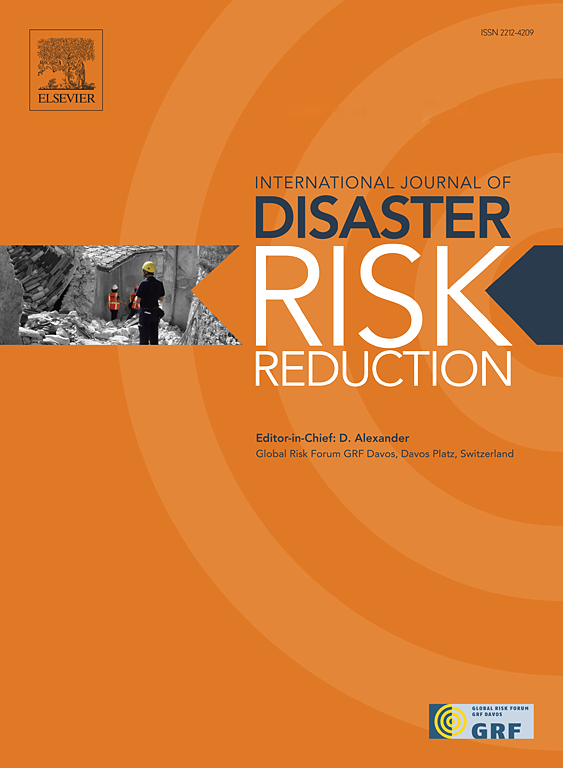赋能“复原力建设主体”:体育教师备灾教学意向分析
IF 4.5
1区 地球科学
Q1 GEOSCIENCES, MULTIDISCIPLINARY
International journal of disaster risk reduction
Pub Date : 2025-07-04
DOI:10.1016/j.ijdrr.2025.105685
引用次数: 0
摘要
体育教师在防灾、协调、安全等方面具有独特的特点,是灾害教育中的佼佼者。本研究旨在了解影响我国体育教师个人备灾行为和将灾害教育融入教学实践的教学意向的心理及情境因素。基于保护动机理论和Paton的社会认知框架,对来自12个省份的6195名教师的数据进行了描述性统计和推断性统计。结构方程模型揭示了信念、批判意识、感知严重性、信任、授权、自我效能、积极结果预期和反应成本在形成一般备灾意向和备灾教学意向中的相互作用。虽然教师报告了中等程度的备灾行为,但他们对学生进行灾害相关主题教育的意图明显更强。调查结果强调了加强机构支持和心理赋权以弥合意愿与行动之间差距的重要性。对政策、教师教育和学校灾害教育策略的影响进行了讨论。本文章由计算机程序翻译,如有差异,请以英文原文为准。
Empowering “resilience-building agents”: An analysis of physical education teachers’ instructional intentions for disaster preparation
Physical education teachers hold unique characteristics, making them prominent figures in disaster education due to their expertise in physical preparedness, coordination, and safety. This study focuses on understanding the psychological and contextual factors that influence PE teachers' intentions to engage in two domains: their personal disaster preparedness behaviors and their instructional intentions to integrate disaster education into their teaching practices in Türkiye. Grounded in Protection Motivation Theory and Paton's social-cognitive framework, the data of 6,195 teachers from twelve provinces were analyzed by descriptive and inferential statistics. Structural equation modeling revealed the interplay between beliefs, critical awareness, perceived severity, trust, empowerment, self-efficacy, positive outcome expectancy, and response cost in shaping both general and teaching intentions for disaster preparedness. While teachers reported moderate levels of disaster preparedness behavior, their intentions to educate students on disaster-related topics were notably stronger. The findings highlight the importance of strengthening institutional support and psychological empowerment to bridge the gap between intention and action. Implications are discussed for policy, teacher education, and school-based disaster education strategies.
求助全文
通过发布文献求助,成功后即可免费获取论文全文。
去求助
来源期刊

International journal of disaster risk reduction
GEOSCIENCES, MULTIDISCIPLINARYMETEOROLOGY-METEOROLOGY & ATMOSPHERIC SCIENCES
CiteScore
8.70
自引率
18.00%
发文量
688
审稿时长
79 days
期刊介绍:
The International Journal of Disaster Risk Reduction (IJDRR) is the journal for researchers, policymakers and practitioners across diverse disciplines: earth sciences and their implications; environmental sciences; engineering; urban studies; geography; and the social sciences. IJDRR publishes fundamental and applied research, critical reviews, policy papers and case studies with a particular focus on multi-disciplinary research that aims to reduce the impact of natural, technological, social and intentional disasters. IJDRR stimulates exchange of ideas and knowledge transfer on disaster research, mitigation, adaptation, prevention and risk reduction at all geographical scales: local, national and international.
Key topics:-
-multifaceted disaster and cascading disasters
-the development of disaster risk reduction strategies and techniques
-discussion and development of effective warning and educational systems for risk management at all levels
-disasters associated with climate change
-vulnerability analysis and vulnerability trends
-emerging risks
-resilience against disasters.
The journal particularly encourages papers that approach risk from a multi-disciplinary perspective.
 求助内容:
求助内容: 应助结果提醒方式:
应助结果提醒方式:


